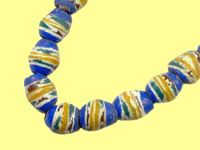The history of African beads is also the history of the diverse life forms that evolved on the continent

The history of African beads is also the history of the diverse life forms that evolved on the continent. The Bead Art of Africa is marked, so dependent on environmental factors, availability and movements of raw materials and the influence of Islamic and European cultures and technologies that are effective for 1400 years.
To understand the African culture pearls, one has the influence of geographical conditions on the character of African societies into account. ) In the different regions of the continent (deserts, tropical rain forests, forest areas, savannas, and fertile river valleys are the natural wealth is unevenly distributed. The different economic, political and religious structures reflect the diversity of natural areas. Jewelry, in its capacity as an indicator of social and economic values as informative as it is a vivid manifestation of the great cultural tension arc that characterizes this continent.
If the power in the hands of one ruler, concentrated, which controlled the available resources - gold and ivory, for example - so that usually went hand in hand with the flowering of arts and crafts. The king or chief, promoted the arts and documented as his personal supremacy. This it did have decent offerings, which he could offer to the gods in gratitude for the protection of his privileged person. Pearl Jewelry also served to distinguish the leaders from the simple people. Therefore, the of skilled craftsmen dedicated to the Yoruba king - or oba - his court-made jewelry and much more elaborate than the one East African pastoral peoples - such as the Turkana and Samburu - work for themselves. However, these beads are an important component of the pastoral peoples everyday clothes are worn, to age marital status or the position within the tribal society to identify.

Pearls are in the whole of Africa is a fundamental medium in a complex communication system. Jewelry - especially pearls - in a symbolic way, the personal circumstances of social, religious, political and artistic performances demonstrated. Pearls are vital for all Africans: that goes for the collectors and hunting cultures of the southern Kalahari Desert, to the prosperous city-dwellers in Nigeria and Ghana. The parade of relationship to the cultural heritage in Africa probably still play a larger role than in other parts of the world.
Bead Materials
For centuries, the Africans had a tremendously wide range of pearls and raw materials. Across the continent, many organic materials have been used for the manufacture of jewelry - for example, seeds, nuts, shells, bone, ivory and teeth -. The earliest known beads are disk-shaped and made of ostrich egg shells, was discovered at her Upper Paleolithic sites (10 000 BC) in Libya and Neolithic sites in the Sudan. Even today, ostrich eggshell in east Africa now and then processed into beads, the Kung San in the Kalahari Desert, for this local stuff even large amounts of solid beads - beaded strand to her -! Also cowries, because of their durability and shape (they symbolize estimated female fertility), have a long tradition in African culture pearls. More than 10 000 years cowries were placed the deceased in the grave, until quite recently Kauri was recognized as legal tender.

The production of stone beads in Africa south of the Sahara was limited to a few places. The Nok Culture in Negeria in 1st Millennium BC was already the production of cylindrical and double-drilled stone beads known. They discovered a male Nok terra-cotta figure, which apparently takes a necklace of stone beads. This tradition was for a long time: How were bronze beaded royal figures from the Ife culture of the 15th Century AD found. Beads, which were recently excavated in Djenne in Mali, show that there at least during the European Middle Ages stones processed into jewelry. In the 15th Century, developed under Oba Heue EWAR the Great in the Kingdom of Benin (Nigeria), a stone beads manufacturer, which are increasingly skilled and specialized on agates. As significant was the role these pearls in ancient Benin, you read it because the oba deserving subjects) by a member of the House of Iwebo (guardians of the royal coat specially made dress with pearls. No noble dignitary was admitted without his pearl jewelry to oba, and if he lost, could mean the death penalty. The royal insignia of the oba became increasingly elaborate, until the 17th Century, the official Königsornat consisted entirely of coral beads, including skirts, shirts, crowns, scepters and staffs. The Portuguese had in the early 16th Coral century brought to Africa.
Also in Ilorin in Nigeria, there was a stone bead industry. Duch and Sudanese Arab traders arrived small agate, carnelian, red Jaspisklumpen and even old stone beads in Ilorin, where they were reworked by local craftsmen to encrypt and pearls. The majority today found throughout Africa agate and Karnelperlen but come either from India or are copies of Indian beads, made in the 19 and 20 Century in Idar-Oberstein. Now produce the Dogon of Mali are still large granite beads.





